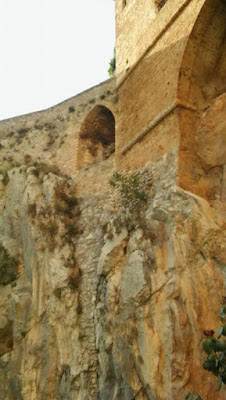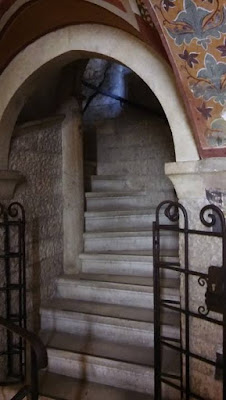 |
| St. Benedict's Monastery |
 |
| St. Benedict's Monastery |
St. Benedict's Monastery in Subiaco felt like heaven, literally. Spending time here was truly a mountaintop experience! Just as we suffer and struggle to reach the ultimate goal of heaven, reaching St. Benedict's Monastery was also a mighty challenge, at least it seemed so to me. Massimo, our skillful driver, took us on a harrowing ride up a narrow, one-lane, winding road with deep drop-offs to reach the monastery which was at the top of the mountain. Every once in a while a car would come from the opposite direction and Massimo would have to pull over and let them pass. How those cars were able to pass on that narrow road was truly a miracle. Despite Massimo's skill, we passengers were overly fearful. Seriously, there were a few screams and calls to Fr. Bill to offer general absolution to everyone on the bus in case we fell over the side and never reached the monastery. Massimo was probably laughing at the foolishness of his passengers who were lacking trust both in his skill and the providence of God.
At the bottom of the mountain, as we were beginning our ascent, we passed the ruins of Nero's Villa, a place where the Roman emperor went for rest and relaxation. The Villa had been completely built by slaves during Nero's rule between 54 and 68 AD. Further up the mountain we passed the Abbey of St. Scholastica, named for St. Benedict's twin sister, the only one of St. Benedict's monasteries which had not been destroyed by earthquakes but which had been partially destroyed by bombs during World War II only to be reconstructed once again.
 |
| Abbey of St. Scholastica |
 |
| The ruins of Nero's Villa at the bottom of the mountain |
 |
| The ruins of Nero's Villa at the bottom of the mountain |
 |
| Steps outside the monastery |
Arriving at the monastery we were overjoyed, not only that the thrilling ride was over, but mostly because the mountaintop monastery was so exquisitely beautiful! The monastery was built right into the side of the mountain and encompasses the Sacro Speco, the cave where St. Benedict spent three years as a hermit. Our time of prayer and discovery here was very fruitful and, I would add, it was my favorite stop on our entire itinerary. It was definitely hard to top our visit to this serene place of prayer!
St. Benedict was born in Norcia to a Patrician family in the fifth century. He studied the liberal arts in Rome but was put off by the immorality of the city and left for solitude in the mountains in what is now a National Park in Subiaco. He met some monks living in the remains of the Villa of Nero who told him that if he wanted to be a hermit he would have to live in a cave. For three years he lived the life of a hermit in a cave. Baskets of food were occasionally lifted up to him by a local monk using an unreliable rope system. The monk would fill a basket with food and ring a bell to let Benedict know that the food was there. Then Benedict would throw down a rope by which he'd lift the basket of food up to his cave. When he finally left his cave he went down to the valley and started his monastic rule.
 |
| Marble image of St. Benedict in his cave by Antonio Raggi |
St. Benedict's death occurred forty days after the death of his twin sister, St. Scholastica. The twins, St. Benedict and St. Scholastica only saw each other once each year. On their last visit St. Scholastica begged St. Benedict to stay longer but he said no. So she prayed about it and God immediately sent a thunderstorm requiring the two saintly siblings to remain together for the remainder of the night. St. Scholastica died three days later. Could it be that she knew she didn't have much longer to live when she begged to remain with her brother for a longer period of time? Forty days after that St. Benedict died at one of the twelve monasteries that he founded, Montecassino, where he is buried. The year was 547.
The Monastery of St. Benedict is built over the Sacro Speco, the cave where he lived for three years. Interestingly, St. Benedict did not found this particular monastery. St. Benedict is the founder of monasticism and the patron of Europe and of exorcists. His medal is found within every crucifix that is used for exorcisms.
We were so blessed to spend time exploring the monastery and to have Mass in the beautiful upper church.
Bishop Don told us that monasticism emerges as a way for people to really grab hold of the fundamental teachings of life. It reminds us that God calls us to be holy because he wants our holiness to bless, sanctify and lead others to the kingdom of heaven. He wants us to become overflowing fountains of grace to sanctify other people, not just ourselves. Through the saints we've journeyed with-Francis, Clare, Catherine, Benedict-we discover our own identity and purpose.
In his homily on Luke 17:11-19 regarding the ten lepers that were healed yet only one returned to give thanks, he said "Gratitude is the most foundational virtue along with humility. Everything else hinges on that. Entitlement and pride are never satisfied, they are always looking for a higher place. Gratitude takes a lower place because it knows that it has already been given so much. When you think of everything you've been given by God you'll want to give to others. Think of the hands of Adam and Eve reaching out like claws to grasp the fruit. Then think of Jesus on the cross hands open and giving completely, handing himself over as a gift for the sake of the world. Thanksgiving isn't a day on the calendar, it's a way of life."
I can honestly say that I am very thankful that I was given the opportunity to visit this amazingly beautiful and holy place. I've never seen anything like it! I hope you enjoy the many pictures below of the mountain area and of the monastery. The pictures aren't the best quality but I just wanted to share everything! I wish everyone could visit here in person! Next, on to Rome!
 |
Way down the mountain I spied a goat and captured him on zoom.
This almost looks like a painting, doesn't it? |
 |
| View from a monastery window. |
 |
| St. Benedict and St. Scholastica |
 |
| The Martyrdom of St. Placid by beheading including a monk having his tongue ripped out |
 |
| Stairway leading to the Sacro Speco |
 |
| The skeleton depicts death |
 |
| I love the three-dimensional aspect of many of the halos. |
 |
| Patricia, our guide, calling to us from an upper window telling us that it was time to go. |















































No comments:
Post a Comment